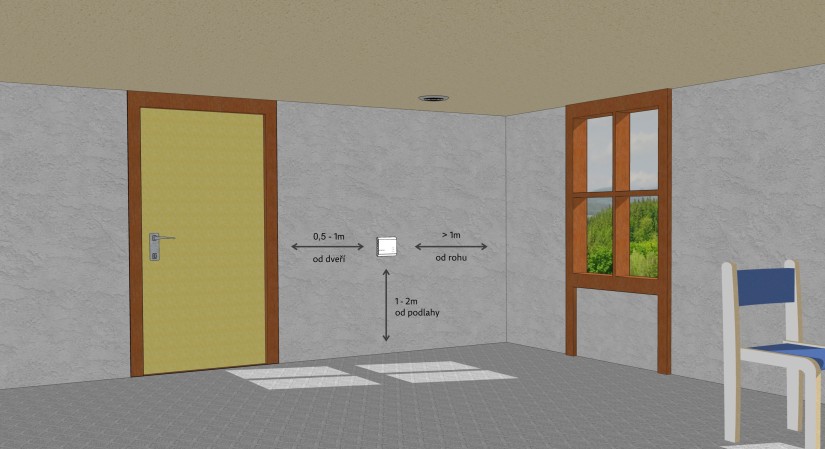Suitable conditions
- In places that are most telling in terms of indoor air quality
- At a height of approx. 1.0-2.0 m above floor level on the inner walls
- At least approx. 1 meter from the corner of the room
- At least 0.5-1 m from the door
- In places where the temperature ranges from approx. 10 - 40°C
- Close to (not in close proximity to) the air exhaust from the room
Unsuitable conditions
- Near the windows
- Near the front door
- On external (perimeter) walls (depends on wall insulation - surface temperature of external walls)
- In places with limited air circulation such as vestibules, alcoves, etc.
- In places with sudden changes in temperature
- In places with sudden changes in humidity
- In places where air humidity condenses
- In places where people would directly exhale on the sensors
- In places where there may be vapors of various chemicals such as cleaning agents and the like
- In places where there is a danger of splashing the sensor with various liquids

If you place the sensor directly next to the table or right next to the bed (or above it), etc., breathing can adversely affect the sensor's measurements and report higher values than they actually are. And that's because a person exhales (in addition to other pollutants) roughly 100 times higher concentration of carbon dioxide than there is in the outdoor air! The outdoor concentration is usually below 450 ppm, then a person exhales air that contains 40,000-50,000 ppm!
The best location is 1 - 1.5 meters above the ground, approximately at the height of the switches. If we take carbon dioxide itself, it is indeed heavier than air, but it usually mixes well in normal space due to the movement of people and natural infiltration or ventilation, so the location of the sensor in terms of height above the ground is not so important. In a really tight bedroom, it is good to place it at head height.
There is poor air circulation in the corner of the room, and the sensor might not detect an increased value of air pollution. Likewise behind furniture, where the sensor can also get quite dusty - this increases the risk of filter clogging.
At the window (whether it is open or closed) and the door - and especially the entrance door - outside air can act on the sensor due to possible leaks. This can falsely lower readings and the room could then be under-ventilated based on distorted information from the sensor.
It is not advisable to place the sensor in areas where the humidity or temperature changes (very) sharply. The sensor would not benefit at all from direct contact with liquids - so place the sensor where it cannot be splashed with water or chemicals.
The article is prepared according to the information provided by Protronix, a Czech manufacturer of air quality sensors, further information, including the range of supplied sensors, can be found on their website cidla.cz/en.
 English
English